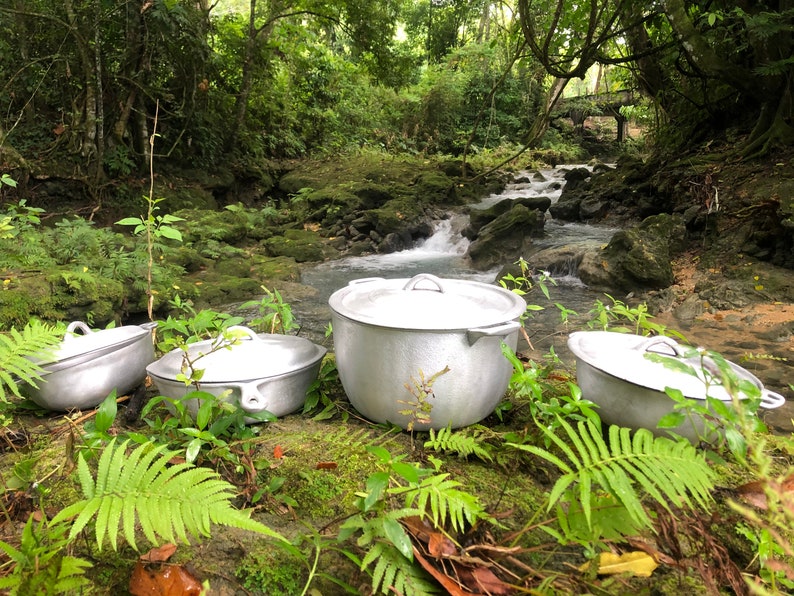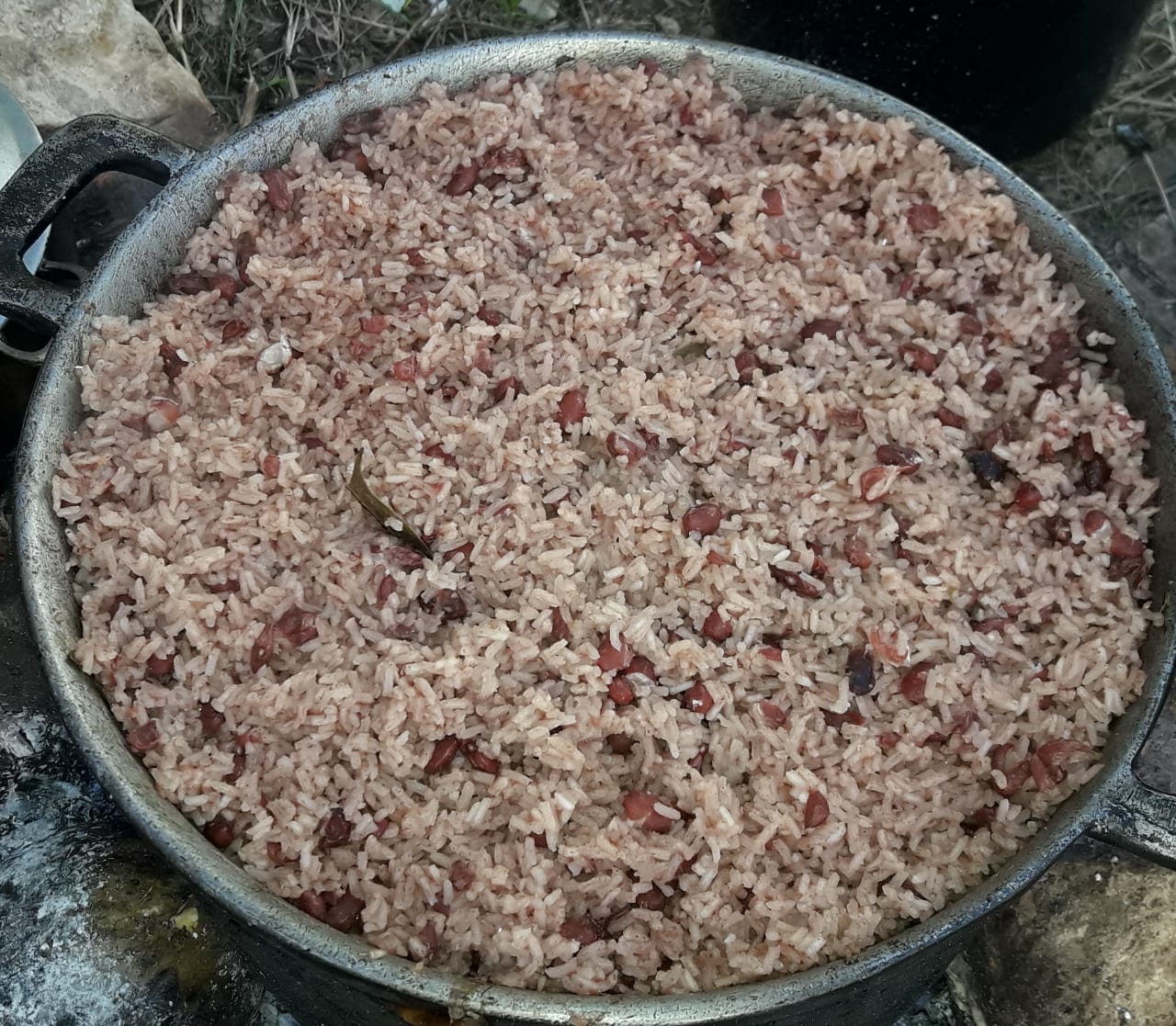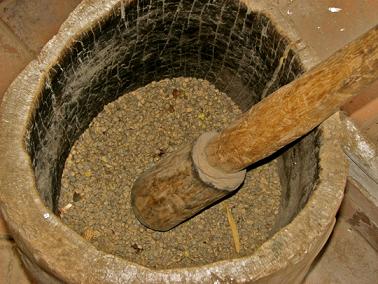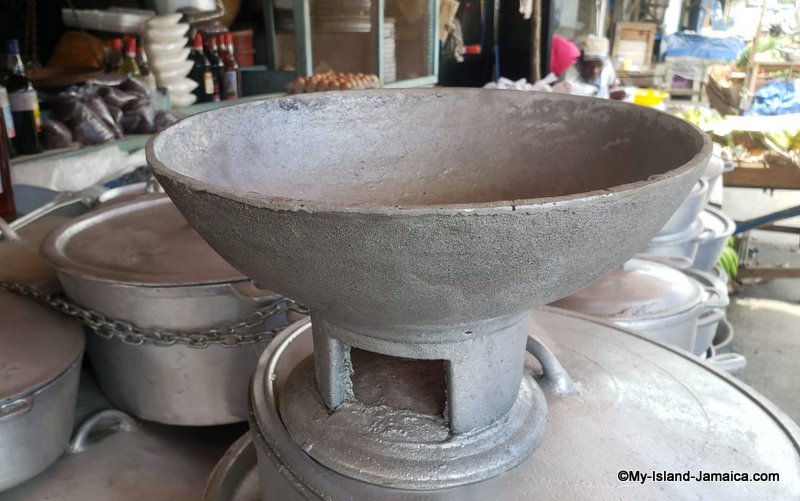Subscribe for all my updates and don't miss a thing! Sign me up!
Jamaican Utensils
Coal Stoves, Dutch Pots & Other Kitchen Weaponry
Sharing Is Caring! Share this awesome content with your friends now.
by Kesha Stewart | Associate Writer
Replicating the Taste of Jamaica in your kitchen is labour intensive. It is not a task for the “fenke-fenke” (weak-willed/easily daunted), you must be ‘Tallawah” (strong/resilient). You also need the right weapons for your battle.
New! Take a piece of Jamaica with you💃!
Savour the memories! Now you can get your authentic Jamaican souvenir items, as well as traditional Jamaican herbs, spices and housewares on our popular e-store. Click Here to learn more.
And, if you ever need a trustworthy and knowledgeable local guide, consider booking a private tour with us!
Dutchie/Dutch Pot
The first weapon in your quest to conquer Jamaican Taste is a Dutchie/Dutch Pot. In the past, this utensil was made in Holland (the Netherlands) and imported by Dutch traders which is alluded to in its name. However, we are doing it ourselves these days.
A dutchie comes in different sizes based on your needs but they are essential due to their versatility. You can fry, boil or bake and even do steamed fish in a dutch pot with amazing results.
It locks in heat and creates a remarkably balanced distribution of heat to ensure your food is evenly cooked. To bake a pudding outdoors, live coal is simultaneously placed below the dutchie as well as on its inverted cover.
Grate/Grater
There is a lot to be said about the humble grater. Varying in size from the large to the extremely small, this bit of punctured metal fixed to a wooden base is a not-so-secret weapon in a Jamaican Kitchen.
Cooks reduce coconut, carrots, sweet potatoes, corn (on the cob), nutmegs and other foods/spices with efficient use of the grater. Of course, you could do this in your blender, food processor or grinder but it's unlikely to be the same taste.
Wooden Spoon
A wooden spoon/turn stick on your kitchen wall will announce your "Jamaicaness" in a heartbeat. It is a respected weapon in reproducing Jamaican taste. This spoon is usually made from almost any wood except bitter varieties such as cedar and bitterwood. My mother recommends sweetwood.
The piece of wood is shaped into a spoon at your desired length. The spoon goes right to the bottom of the pot and puts you in charge of it, especially those large, deep pots used for preparing meals for large gatherings such as family reunions.
It ensures that your food such as soup or turned cornmeal is not adhering to the bottom of your pot and also allows you to combine certain foods well like rice and peas.
The wood selected to make the spoon is important as it will impart its own distinctive flavour to the food. A turn stick is like a spoon but without the hollowed-out part, my favourite kind is made from pimento wood.
Mortar and Pestle
No piece utensil is more labour intensive than a mortar and pestle, particularly the old-fashioned types. Again this is made from wood that is carefully selected and gouged out. Broadleaf and other hardwood types were commonly used.
Softer types were not used because the method used to create the well in the block of wood was impossible for softwood types to endure without coming apart. Fire coals were placed strategically on the block of wood until a sufficiently large hole was created.
This was then cooled with water, carefully washed multiple times and then commissioned into service. Needless to say when your coffee, cocoa, corn or pimento seeds was pounded in the mortar by the accompanying sturdy pestle (mortar stick) a specific flavour is created.
Guava or pimento wood was mainly used to create mortar sticks as they are very sturdy and smooth making them less likely to cause damage to the palms of the hand.
You might be more familiar with the smaller version of this utensil, but the larger ones are used to beat cocoa, castor beans and other ingredients done in large quantities.
Pudding Pan
In the old days, the pudding pan was a large, deep (in some cases wide) aluminium container that was used to do everything from washing dishes by hand to storing fried fish overnight. Nowadays I find that a pudding pan is still valuable even though it is not made from the same material anymore.
In most, if not every single case, a pudding pan is great for a kitchen. A lot of things like combining the ingredients for your pudding or for washing your meats and vegetables. Since we believe in ‘rubbing up’ our meat well, a pudding pan is great to do this kind of thing.
This is a great way to achieve Jamaican flavour because what we do when we rub up our meat is massage in the spices that gives our meats the distinctive flavour that the world loves.
Coal Pot/Coal Stove
A coal pot or coal stove is a great addition to your kitchen. Your roast breadfruit, fried fish and your potato pudding will taste a lot different. The number one thing about a coal stove is that it uses charcoal as fuel and the flavour imparted to your cooking is very similar to what you would get using a wood fire.
But beyond that, it is one piece of weaponry that helps to achieve authentic Jamaican taste. Not sure what this looks like? Let me try and describe it for you. A coal pot also called a coal stove is a fairly small cooker fuelled by charcoal.
The top is shaped like a basin and is covered by a metal grill, which is attached to a long hollow cylinder-like foot. In essence, it is essentially a primitive single cooktop. The modern versions are powered by gas or electricity.
You can still acquire a coal stove and use it in your quest to achieve Jamaican Taste. It is a great addition to your backyard cooking exploits too.
I’m not sure if you knew that these were some of the weapons Jamaicans wield to give our food that longed for Jamaican taste that is authentic and full of flavour. I'm also not sure if Jamaican cooks will bash me for letting the puss (cat) out of the bag. Only time will tell.
Sharing IS Caring! Please help me get the message out by sharing this article with your friends on social media (links below). Thnx ;-)
If you found this page useful, please consider subscribing to my weekly newsletter, to get even more.
It tells you each week about the new information that I have added, including new developments and great stories from lovers of Jamaica!
Return to Jamaican Food from Jamaican Utensils
Return to My Island Jamaica Homepage from Jamaican Utensils
References & Sources For Jamaican Utensils
- Jamaica Gleaner, https://jamaica-gleaner.com/
- Jamaica Information Service, https://jis.gov.jm/
Jamaican Utensils | Written: August 15th, 2022
New! Get My Latest Book👇🏿
|
You asked, I've answered! You no longer need to save for months or years, to enjoy paradise! I spilled the beans! sharing my top tips on finding cozy accommodations and secret gems, only the way a native could! Click Here to pick it up on my e-store and start saving now! |
See The Best Of Jamaica - In Videos!
|
My channel reaches over 140,000 subscribers worldwide and has leveraged over 11 million views, sharing, what I call 'The Real Jamaica'. Subscribe today and join our family of viewers. |
Read More ...
New! Experience The REAL Jamaica!
Book Your Private Tour here and experience Jamaica the way we (locals) do!
P.S. Didn't find what you were looking for?
Still need help?
Click Here to try our dependable and effective Site Search tool. It works!
Or, simply click here and here, to browse my library of over 500 questions and answers! Chances are someone already asked (and got an answer to) your question.

















New! Comments
Have your say about what you just read! Leave me a comment in the box below.